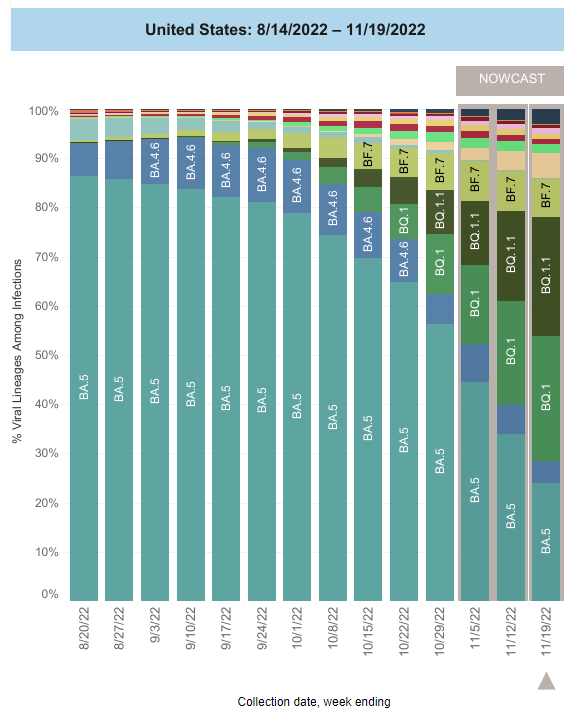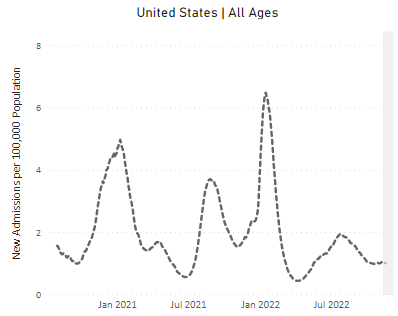The Weather: Transmission levels continue to remain high, with 83.31% of the population currently living in areas with substantial or higher transmission.
A study published in the CDC’s MMWR found that half of adults surveyed perceived local COVID transmission to be low to moderate, despite sustained high transmission. Unsurprisingly, when people perceived local transmission to be high, they used more preventive behaviors.
So the CDC acknowledges that perception of risk is associated with protective behaviors. Since the CDC refuses to do so, we will continue to tell the truth: Almost the entire country has been experiencing high or substantial transmission for months.

On Variants: The variant picture continues to shift, with BA.5 proportions continuing to drop and BA.5 subvariants BQ.1.1 and BQ.1 continuing to rise.
BA.5 now represents only 24% of cases; in contrast, BQ1.1 and BQ.1 now represent a combined 49.7%, up from 44.2% last week.

Wastewater Monitoring: National wastewater levels have remained relatively stable over the past month.

Hospitalizations: New admissions hospitalizations with confirmed COVID remain steady for the past several weeks around 1 per 100,000. However, flu and RSV have created capacity issues in pediatric healthcare systems across the country.

Read a letter from over 30 physicians groups to the White House describing the overwhelmed state of pediatric emergency rooms and hospitals across the country and calling on the Biden Administration to help.
The Biden Administration declined their request, saying that the issues described in the letter were to be addressed at the local level.
Deaths: Between November 9 and November 16, 2,222 people died of COVID nationally. Over 245,000 people have died of COVID in the US this year so far.
Forecast: With air travel estimated to be the highest this Thanksgiving since the start of the pandemic and protections such as mask mandates abandoned we may see increases in cases over the next few weeks.
This week, the People’s CDC released guidance for Safer In-Person Gatherings. While the safest option is always to move gatherings to a remote format, we understand that many people will gather in-person. These guidelines describe various layers of protection to #SeeYouSafer.

Take Action: Want to join the calls to demand protections for workers? @NationalNurses put out this amazing tool to help us write letters to the editor requesting permanent OSHA Standard for COVID-19.
#COVIDIsAirborne and #BringBackMasks trended again in reference to CDC director and Biden administration continued omission of universal masking for prevention of COVID and other respiratory viruses. We must continue to organize and fight dangerous public policy.
Over 48k graduate workers & post-docs across the University of California system are on strike. Organizers are working to include more COVID-19 protections in the contracts. If you join the in-person picket lines, be sure to follow these covid safety tips.
Notes: 1) The numbers in this report were current as of 11/17. The CDC updates data frequently as it receives refreshed information. Today’s numbers may be slightly different from the data here. 2) Check out the links throughout & see our website for more! https://bej.gbh.mybluehost.me.